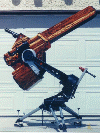
Observing with my 10-inch f/17.25 Tetraschiefspiegler
has been a source of great pride and thrilling discovery.
My interest in tilted-component-telescopes (TCTs) and unobstructed reflectors (Schiefspieglers) developed in the spring of 1993 after a fellow enthusiast sent me various ATM articles by A.L.Woods, Oscar Knab, Richard Buchroeder, and others. I couldn't help but be intrigued by the words of Anton Kutter, developer of the Schiefspiegler (quoted in the informative book, Observing and Photographing the Solar System by Dobbins, Parker, and Capen) that these telescopes "combine the perfect achromatism of the reflector with the unobstructed light path of the refractor. They employ a minimal number of elements, exhibit no false color, suffer no diffraction caused by spiders, diagonals, or secondary mirrors, and have negligible coma and astigmatism, as well as flat field." Other ATM writers have remarked that resolution and contrast are so sharp as to seem that one is viewing from outside earth's atmosphere; that on steady nights, one could push these scopes to 100x per aperture inch; that they are comparable to or better than refractors of equal aperture; and that despite their typical long focal lengths, they are admirably suited for deep sky, as well as lunar and planetary study.
Fired by enthusiasm, I researched these systems wherever I could find information. Although I learned a considerable amount from Allan Mackintosh's books, Advanced Telescope Making, I knew I had insufficient experience in optical design and mechanics to build such a system, so I set about to find somebody capable and willing to help realize my dream. I phoned Dan McConaughy at Lorraine Precision Optics, who encouraged me to build a Tetraschiefspiegler (four-mirror design) for which he had a ready-made set of enhanced-coated mirrors for a 10" system, which he offered at a very attractive price. Now I at least had the mirrors, plus considerable information written by Dan and M. Brunn of Germany, who designed the tetra system. But I could barely compehend the symbols, and urgently began a search for someone qualified to construct it for me. Enter Jack Wolfe, a retired optical designer for the U.S. Army, and master wood craftsman as well. He expressed strong enthusiasm for the project, and agreed with my desire that it should have the finesse and style of a fine old Italian violin. In two months, Jack was at my door with the beautiful Arkansas cedar tube assembly he'd constructed. We very carefully assembled the components, straddled it between the forks of my Byers retrofitted C-14 mount, collimated all the elements, and star-tested it. It was good, but it didn't approach Jack's expectations. He had not had the benefit of possessing the mirrors during construction of the tube, and in retesting he determined that the less than optimal performance was due to the mirrors having longer radii of curvature than the design specified. Three months later, Jack was at my door with a new primary tube that more accurately approached the mirror parameters. Now the viewing was not just good, but spectacular, with sharp stark pinpoint star images combined with high contrast velvety black sky. The telescope's First Light was celebrated during the last lunar eclipse during the the Thanksgiving holiday, which, of course, allowed us to observe several breathtaking conjunctions and occultations. Most surprisingly perhaps was that it produced a ½° field of view in a 32mm Erfle eyepiece.
Now with the optical problems essentially resolved, other quite serious problems demanded our attention. Most serious among them was that the trunnions had been placed well off the actual center of gravity. To find the true center, we literally hung the tube in a noose from a crossbeam in my garage. I designed and had machined a set of adjustable aluminum bearing plates which connected the C-14 trunnions to the true center of gravity. Now the scope could be moved along both axes with one finger, and gentle application of the locks would retain it. The other main problem was the impractical and uncomfortable necessity of using a stepladder for all viewing other than the zenith. This problem was unexpectedly resolved through an article in my new subscription to Observatory Techniques, issue #8, in Mark Schnoor's article on utilizing short lengths of EMT conduit tubing to replace the long legs of the C-14 tripod. The wedge of the scope now sets 15-inches off the ground, with much improved stability and steadiness; and, I can see all but the horizon without a ladder. Collimation of the four mirrors was at first quite difficult, but became easier with practice. The angularity (and of course, distance) from one mirror to the next is built into the tube, so only relatively fine tweaking is necessary. Modifications are currently in progress to allow for locking it in collimation.
The telescope was a major attraction at the 1994 Texas Star Party, where curious people approached day and night to inquire about it and look through it. It was soon nicknamed Chief Tetra. It was easier to pronounce than Tetraschiefspiegler. I am proud and honored, especially for Jack Wolfe, that the scope won a TSP ATM award of merit for Best Looking Entry.
Dr. Joseph Sylvan
Mirror Data
Primary Ellipsoid 10" dia. 246" RC
Secondary Convex 5.6" dia. 218.5" RC
Tertiary Concave 5.6" dia. 218.5" RC
Quaternary Flat 3" dia.
Curator: Hartmut Frommert
[contact]
[Schiefspiegler Home]
[SEDS]